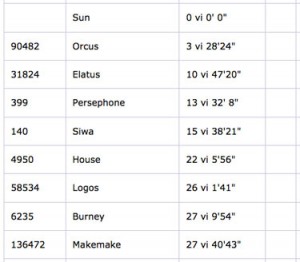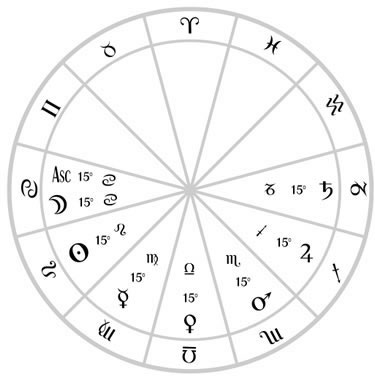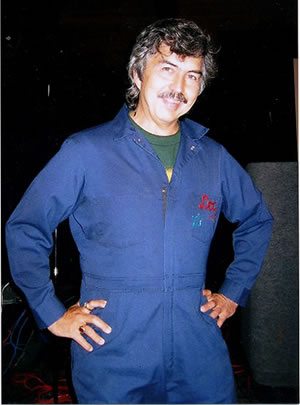Navigate Signs:
Recent Posts
Archives
Featured links:
Considering a Thoughtful Approach to Understanding Astrology
[Note that the origin of “consider” means “to be with the star(s)”]
By Dale O’Brien
What follows is an explanation of my approach to astrology. Regrettably, my type of approach exists in contrast to a far more ubiquitous and careless approach to astrology, present Host Eric Francis, and some others, thankfully excepted. A guy I knew once said to me, “Heck, it’s easy to be an astrologer, I can do this. All I’ve got to do is pull somethin’ outta my ass and tell people that’s the way it is.” Quite simply, such astrologers say “Neptune is ___”, “Pisces is ___” and paste these clichés together like torn paper ransom notes. We can do better than that, and should. Eric’s journalistic background shows us how: Who, What, Where, When and Why are our guiding questions. Combining this information gives a more three-dimensional experience of that planet. Blending this type of perspective for a given planet with its sign placement, planetary aspects, etc. gifts us with interesting and relevant astrology.
Who: Like the ancient discovers of astrology, I don’t see Astrology’s Planets as abstract concepts of the literalist rational mind. Their mythological names correspond to formerly well-known larger-than-mere-human personalities with revealing stories of their activities. Remember that temples of worship were dedicated to the gods and goddesses with much the same names as our planets.
Too few realize that now, as then, certain people “worship” certain Planets, albeit far more unconsciously now.
What: Planetary Entities not only are known for actions, but were traditionally associated with physical elements, costumes, accouterments, physical elements, etc.
Where: In what places in the sky, what places on earth, etc. do we find a given Planet? Note that when thinking of place, know that the signs of the Zodiac previously corresponded to mythological stories. Precession has not negated the inherent memory of that association, with glyphs and Zodiacal imagery as memory aid reminders.
When: When was the planet discovered? When does an ingress or aspect take place? Note that “when” is best addressed in the context of the personality of that planet. Exact transits of Saturn are important; exact transits of Uranus, Jupiter, Neptune or Chiron, for example, do not require Saturn’s precision!
Why: “Just because” is absurdly not “astro-logical.” Planets have their reasons, their preferences and aversions, their depth and complexity, particularly in interaction with other planets. We may have observed a correspondence and not have known why it is so. If that is the case, it is good to not be so sure of oneself in that regard, at least until we have discovered the mythic correspondence to explain that “why.”
Posted in Featured Articles
Leave a comment
Introduction to the 2012 Charts
The charts you have in this section are different than the charts I used to write and record your 2012 astrology readings. I include charts for the sake of new astrology students who want to study the planetary dynamics on their own. Here is a glyph legend — though note that Eris in this legend does not match Eris in the charts that you’ve got here. I’ll explain why in a moment.

Example of an ephemeris lookup from Serennu,com. This lists all the planets that will be in Virgo at the time the Sun makes its ingress into that sign. You can tell it's the solar ingress becaue of the degree value of the Sun -- 00 degrees and 00 minutes. This is part of a 360-degree sort -- a look at the whole sky, in order of the signs, at the time of the event.
First I’ll describe the ones that I’ve used to write and record your presentations. I use a diversity of different charting methods, but most of the time I run horoscope wheels in Time Cycles Software, a good program for Mac. It has the main advantage of a clear chart display that works well for beginners.
And there is one feature called Io Sprite, which allows for a real time animation of the planets’ places, as well as animating accelerated movements forward and reverse. Io Sprite is also great at finding specific positions and aspects, as long a they don’t involve any of the minor planets besides the first four asteroids and Chiron.
The main charts I used to do your readings were those of the ingress of the Sun into your sign. This is a dependable method for testing the energy and reading the narrative of a sign for the year in question. I also used charts for key events, such as eclipses, the Venus transit of the Sun, Mars retrograde and Saturn ingressing Scorpio. And I’ve been hanging out with the Uranus square Pluto charts for a long time.
As mentioned, the charts in Io don’t give a lot of minor planets. For most astrologers they are not so bad; you get the first four asteroids, the first three centuars, Eris, the major planets and a few odd points. But that’s not enough for the kind of work that I do. For all the other planets, I use Tracy Delaney’s ephemeris tool at Serennu.com. Note that you can sort the planets many different ways. For this project I used 90-degree and 360-degree sorts.
A 90-degree sort focuses on the alignment of all the planets on a particular cross; for example, if the Sun is at 00 Aries, a 90 sort would pick up everything near that degree, and near 00 Cancer, 00 Libra and 00 Capricorn. I use that to scan major aspects to the Sun on the day that it arrived in your sign.
A 360-degree sort tells you what is in each sign, in order of the signs. It’s a way to look at the whole wheel in sequential order. I use that to scan the full contents of a sign on the day of the Sun’s ingress.
The charts you have in this section were cast in Solar Fire, probably the very best commercial astrology program in existence. If there is a better one I don’t know about it. Solar Fire has many options for including the minor planets. Kirsti Melto, our astrology research assistant in Finland, cast the Solar Fire charts for us.
The inner wheel includes the major planets, the first four asteroids, Eris and a few other points. Note that the glyph for Eris is different than the one you may be used to seeing in the charts I publish — we have not settled on this matter, and different software makers use different symbols. Eris in these charts is a little like a black Pisces symbol, but placed in Aries.
The outer wheel includes all of the named centaur planets. I have included them because they are a focus of my astrology research, they are fascinating little critters, and there is a huge stampeded of them going through Sagittarius at the moment. The named centaurs in our charts are:
Chiron
Pholus
Nessus
Hylonome
Asbolus
Chariklo
Pelion
Okyrhoe
Cyllarus
Elatus
Echeclus
Bienor
Thereus
Amycus
Crantor
Some of these have writeups in the Small World Stories listing of planets.
Posted in Astrological Charts for 2012
Leave a comment
Pluto is in Capricorn — Everything Old is New Again
By Eric Francis with help from Ma Kettle. This originally appeared in Cosmic Confidential.
The Shaving Brush and Mug
Discovering my first shaving brush (at the local food coop) and mug (with some searching around town) was what inspired the idea that some very cool old things can have a new role in a sustainable world. Well, it was actually my second encounter with the shaving brush — when I was about five and my father showed me how to shave, half of the instructions involved the use of the brush and mug; they were still in common use in the Sixties.
Decades and many cans of Edge later, I discovered that the shaving brush and soap were better, less expensive, more fun, cheaper and far more environmentally friendly than canned chemical shaving cream.
These became the criteria for “Everything Old is New Again”: the old item or method had to be better, less expensive and more ecologically friendly than the new one. Yet nearly everything we suggest on this list has one other common theme: it requires a skill. In every case, the older, better method requires you to know something, or take care of something, in a way that the modern method does not. The little cake of shaving soap you put at the bottom of a ceramic cup will last for a year or longer, if you keep it dry between uses. Part of the skill is keeping it dry. The soap comes in a cardboard box; that’s the only packaging. A good brush, if you keep it dry between shaves, will last for years. It’s fun to whip up all that lather, which comes out warm if you use warm water. And for ladies it’s the most fun of all: the brush has the approximate consistency of a tongue, but it never gets tired and it’s available any time. You’ll be sitting on the edge of your tub for hours on end.
Posted in 2012 Diary
3 Comments
Special Edition Audio: It’s All About the Houses
[audio:http://planetwaves.fm/podcast/111230signs.mp3]

In this special edition of Planet Waves FM, I explore one of the most commonly asked questions about “general” readings — how does the astrologer make them specific? How can we get any detail at all, just knowing someone’s Sun sign? (By the way I just heard a ridiculous verbal typo – toward the beginning, I say the word ‘simultaneously’ when I mean ‘synonymously’. It’s an interesting blend of concepts anyway, as one implies time and the other implies meaning.)

The Thema Mundi, the key to the logic of astrology, including rulership, aspects, house meanings and the basic order of the solar system. It is probably modern astrology's oldest artifact besides mythology itself, dating back to ancient Greece.
This discussion will be interesting for both astrology fans and astrology students. I describe the solar house system, which counts the houses off of the Sun, and the whole sign house system, which uses the whole sign as a house. I also describe how astrology is a holographic art — and because I am using a whole chart for each of the readings, I can interpret a complete story that you can relate to.
Technical note: “ascendant,” “1st house” and “rising sign” are all the same thing, for our purposes here.
There are a few resources that might help ease your way, if you want to go deeper into understanding the astrological houses. One is a basic description of house meanings. Here is another one, that focuses on sexual themes through the houses. In this article from way back when the Internet was young, I describe how horoscope writers use the solar houses and whole sign houses. Finally, in this article from Cosmic Confidential, I describe my holographic method of reading for the signs, which allows the use of a full chart — granted, a simpler chart — and why it helps that an astrologer sees the whole chart and creates a cohesive narrative. That, I think, is the key. Okay so — just thought of one other, one that skips back into the earliest history of astrology as we know it in old Greece – the Thema Mundi. The Thema Mundi may be modern astrology’s oldest artifact. It’s a single chart, a teaching chart, that describes the logic system behind astrology.
Posted in 2012 Diary
Leave a comment
Top Five Events: The ‘End’ of the Mayan Calendar
[audio:http://planetwaves.fm/podcast/120101top5.mp3]
Note — I’ve added the second part of this edition — the interview with Carlos Cedillo, the Mayan daykeeper, who explains various aspects of the Mayan calendars. It’s about a one-hour interview and you can hear it in this area devoted to the Top Five Events of 2012.
Good evening. I’ve just recorded a new entry in the Top Five Events of 2012 series, this one addressing the Mayan calendar systems and what day 13.0.0.0.0 on Dec. 21, 2012 might “mean.” It’s actually a critique on attempts to pin too much meaning on the day. And, for the most part, I’m not up to giving my opinion yet — though I do provide some thoughts by other writers. There will be two more parts to this part — next, an interview with Carlos Cedillo, a daykeeper, and then the last in the series — my own viewpoint on the matter of the Mayan calendar and 2012. You do get a bit of that in this recording, but not the heart of my theory.
The article I reference by Bruce Scofield will appear in the rapidly growing resources area for the Reality Check website. This presentation will appear in the Top Five Events special area as well. If you want to pre-order your Reality Check reading, check the the link on the top of the right column.
Posted in 2012 Diary
Leave a comment



